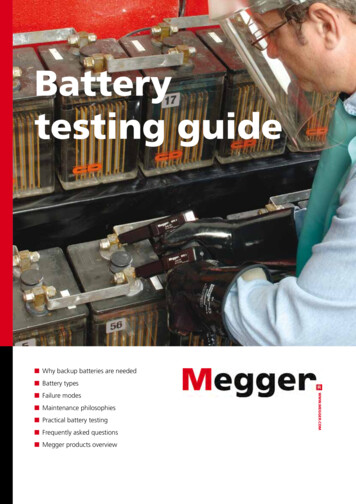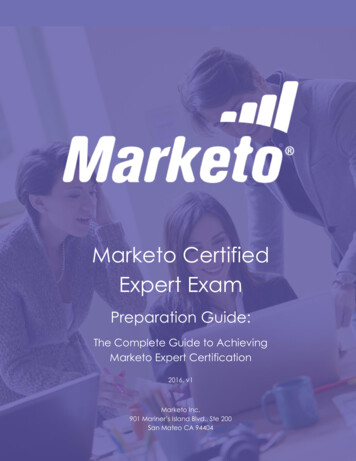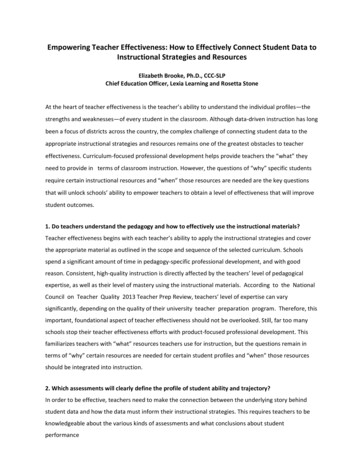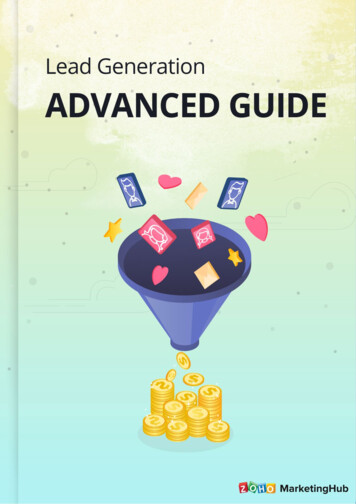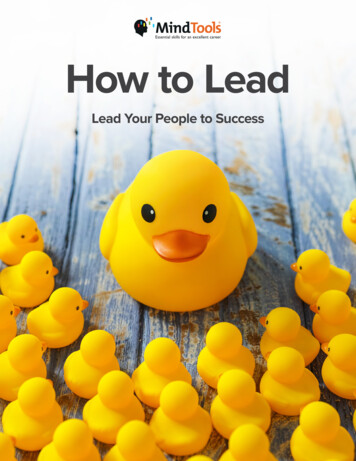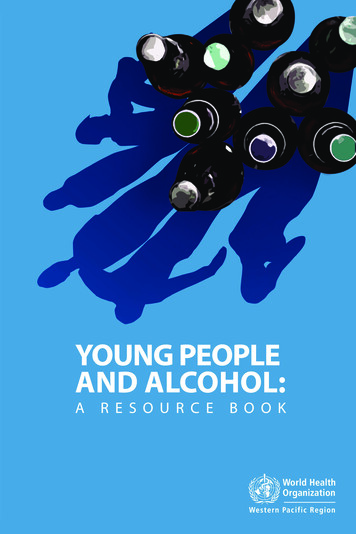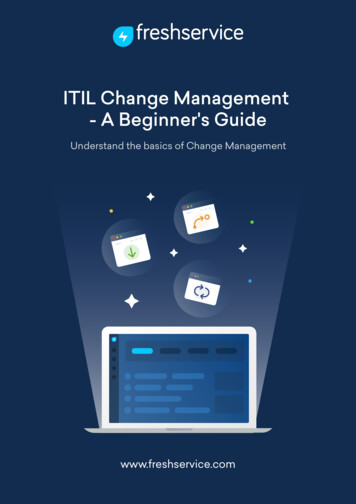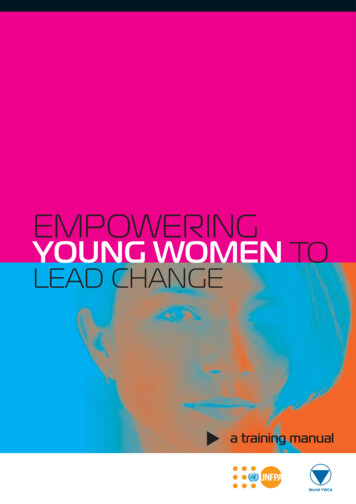
Transcription
EMPOWERINGYOUNG WOMEN TO LEAD CHANGEa training manual
ACKNOWLEDGEMENTS“Empowering Young Women to Lead Change” is the result of hard work andcreativity from many people. The World YWCA extends its gratitude to:The United Nations Population Fund (UNFPA) for its generous support inproducing this manual.Natallia Aleksandrovich from Belarus, Tarusila Bradburgh from Papua NewGuinea, Kylie Head from Canada, Grace Kyriakos from Lebanon, Cecilia MukosaChomba from Zambia, Katya Pineda from El Salvador, Lourdes Saad Olivera fromArgentina, Judith Vink from Belgium, and Henriette Yimguin from Cameroon,members of the young women’s resource group who have provided invaluableguidance.Testing workshop participants and facilitators from the YWCAs of Belarus,El Salvador, Jamaica, Lebanon, the Philippines, and Zambia whose feedbackensured that this document is useful and practical. Roselle Dalzine from Trinidadand Tobago and Leila Passah from India who helped turn brilliant ideas into atangible result.EMPOWERING YOUNG WOMEN TO LEAD CHANGEEmpowering Young Women Manuala training manualProduced bySupported byWorld YWCAUNFPAThe YWCA is at the forefront ofempowering women and girls whoadvocate for their rights and leadsocial, political, economic and civicchange. Today the YWCA reachesmore than 25 million women and girlsin 122 countries, providing them withthe space and skills to developleadership for the benefit of entirecommunities. The World YWCA’spurpose is to develop the leadership ofwomen and girls around the world toachieve human rights, health, security,dignity, freedom, justice and peace forall people.The United Nations Population Fund,UNFPA, is an internationaldevelopment agency that promotes theright of every woman, man and childto enjoy a life of health and equalopportunity. UNFPA supportscountries in using population data forpolicies and programmes to reducepoverty and to ensure that everypregnancy is wanted, every birth issafe, every young person is free ofHIV/AIDS, and every girl and woman istreated with dignity and respect.(UNFPA logo) World YWCA 2006. Published in 2006 by the World YWCAWe encourage you to photocopy or quote from this publication as long as credit is given to the source.This manual is available online at: www.worldywca.org
EMPOWERINGYOUNG WOMEN TOan easy to follow resource manual designed to enableyoung women to prepare and facilitate workshops LEAD CHANGEa training manualUnited Nations Population Fund220 East 42nd St. New York, NY 10017 U.S.ATel 001 212-297-5000www.unfpa.orgWorld YWCA 16, Ancienne RouteCH - 1218 Grand-Saconnex, Geneva, SwitzerlandTel ( 41) 22 929 6040 Fax ( 41) 22 929 6044Email: worldoffice@worldywca.orgwww.worldywca.org
EMPOWERINGYOUNG WOMEN TOLEAD CHANGE a training manual
1contentsPreface2Introduction3Tips for Facilitators4Icebreakers, Introduction and Tonesetting515Economic Justice23HIV and AIDS33Human Rights49Peace71Self Esteem and Body Image81Sexual and Reproductive Health95Violence Against Women109Empowering Young Women ManualYoung Women’s Leadership
2prefaceYoung women encounter challenges everyday. Apart from sharing their communities’struggles over limited resources like water, land or jobs, many systematically facediscrimination simply by virtue of being female. This includes physical and sexualviolence, being kept out of school, disproportionate vulnerability to HIV infection andlack of access to property and other rights.Yet young women around the globe possess the collective power to change their lives,their communities and the world we live in. Just as they face daily challenges, youngwomen are continually developing innovative, effective ways to improve their lives. Bybringing together their wisdom and creativity, young women are leading change.Understanding that investing in young women’s leadership is essential to social changenow and for the future, the World YWCA with the generous support of UNFPA, hasdeveloped this training resource for and by young women.Empowering Young Women to Lead Change is designed to support the development ofyoung women’s skills and to enable them to provide leadership on the issues thatconcern them. It offers engaging and dynamic activities to motivate and enable youngwomen to believe in their abilities to catalyse change and to mobilise others to do thesame. It is a flexible tool for learning and exploring issues from human rights andviolence against women to body image, self-esteem and developing leadership skills.Young women in Africa, Asia, the Caribbean, Europe and Latin America in fiveworkshops have field-tested this manual.“A small group of thoughtfulpeople can change the world.Indeed it is the only thingthat ever has.”Margaret Mead“The need for changebulldozed a road down thecentre of my mind.”Maya AngelouThe World YWCA affirms the importance young women’s leadership and theirmeaningful participation in decision-making. This is done in part through a mandatoryminimum representation requirement of at least 25 percent young women in alldecision-making bodies at national and world levels. Presently, half of the members ofthe board of the World YWCA are young women. In addition, the World YWCA offersyoung women training and support to become effective leaders. These includeinternships and exchange programmes; leadership training for young women at allregional and global events; as well as an electronic forum designed to provide asupport and information network for young women leaders at all levels. Over 600,000young women have been trained for leadership over the past four years, which makesup nearly 40 percent of all YWCA training opportunities worldwide.UNFPA is guided by the Programme of Action of the International Conference onPopulation and Development (ICPD) agreed on in Cairo in 1994 and other relatedinternational agreements, including the UN Millennium Declaration. The ICPDdocument asserts that the empowerment and autonomy of women and theimprovement of their status, safeguarding young people's rights, promoting genderequality and equity are highly important. Providing opportunities for learning and forprotecting the health of young people, including their sexual and reproductive health,are crucial for adolescents and youth to reach their full potential.UNFPA works with a range of partners and with young people to encourage thedevelopment of young women and men through participatory, culturally sensitive andrights-based programmes.UNFPA is pleased to partner with the World YWCA in producing this manual, which itbelieves will be a most useful resource in developing and empowering young people.Empowering Young Women ManualWe hope this manual will be a valuable training tool to support the empowerment ofyoung women around the world.Rogelio Fernandez-CastillaDirector, Technical Support DivisionUNFPANatalie Fisher-SpaltonDeputy General SecretaryWorld YWCA
3This manual is designedto put young women incontrol of educating andempowering themselvesto take action on keyissues that affect theirlives.A resource group of women leaders andactivists under age 30 from ninecountries was established to guide theproduction of this publication. Throughconsultation seven key issues wereidentified as having a crucial impact onyoung women. These issues areHIV/AIDS, sexual and reproductivehealth, self esteem and body image,violence against women, human rights,economic justice and peace. Focusing onthese issues, the manual provides youngwomen with information and tools to:Gain insights into the issuesFacilitate training to educate andmobilise her peers to collaborate on theissuesDevelop advocacy skills and takeconcrete action on the issuesThe manual has been tested in Belarus,Jamaica, El Salvador, Lebanon, Zambiaand the Philippines to ensure it is apractical and youth friendly resource indiverse cultural settings.The workshop guides included in eachmodule are designed to enable youngwomen to successfully lead fun andengaging workshops without need for‘expert facilitators’. The curriculum isflexible and allows for adjustments, suchas special speakers or resource people,to suit the needs of the participants. Themodules may be used alone or in anycombination that best meets participants’interests, requirements, available timeand resources.Users may wish to hold half or one-dayworkshops on each of the modules. Orall of the modules can be combined tocreate an eight-day leadershipdevelopment training.There are also a series of warm-up,introductory and icebreaker activities tochoose from to incorporate into trainingswherever necessary.Although this manual has beenspecifically designed as a tool for youngwomen, organisations or individualsworking with young women may also findit a useful resource.The following principles for working withyoung women promote cooperationacross generations, and effectiveprogramme development.KEY PRINCIPLES FOR WORKINGWITH YOUNG WOMENRESPECTHave faith in young women’s leadershipand our ability to overcome challenges.Give us the space and support to lead.CONSULTAsk young women for solutions to theproblems we face. Ensure that we areinvolved in making decisions that affectour lives.PEER LEARNINGYoung women are most receptive tolearning life skills from other youngwomen. Allow space for young women tocollaborate and learn from each other.OPENNESSBe creative and open-minded. Respectand encourage young women’s creativeproblem solving.EXPERIENCEYoung women learn best by doing.Provide opportunities for experientiallearning. Allow us to take risks and learnfrom mistakes.FUN!Remember to laugh and enjoy yourself.Young women appreciate the value of agood time, even when hard at work forsocial change.Empowering Young Women ManualintroductionEmpowering Young Women to LeadChange is a training tool for youngwomen to catalyse positive change intheir lives and communities. This manualis designed by and for young women, aspart of the World YWCA’s commitment todeveloping effective young womenleaders. This manual is designed to putyoung women in control of educatingand empowering themselves to takeaction on key issues that affect theirlives. The modules foster self-determinedapproaches to developing leadershipskills and awareness of their strengthsand rights. It creates practicalopportunities for young women todetermine and direct the changes intheir lives.
4tips forfacilitatorsSET THE TONEIt is essential to establish a positive atmosphere at the beginning of eachworkshop. Emphasise the importance of respecting confidentiality and differencesin opinion. Promote a feeling of sisterhood and fun among participants.Introductions, icebreakers and tonesetting are useful for supporting a safe yetchallenging environment. The exercise “Ground Rules” is particularly useful whensensitive issues such as violence and self esteem will be discussed.MIX AND MATCHMany of the issues covered in this manual are interrelated. Do not be bound bythe layout of each workshop. If for instance, you would like to run a workshop thatfocuses on the impact of self esteem or violence against women, choose theactivities from each workshop that are most relevant to your objectives and createyour own training. Perhaps you feel that an exercise from the economic justiceworkshop can be adjusted to bring home a point about peace with justice. Adaptit! Otherwise you can join several workshops together and host weeklongleadership training. The workshop guides in this manual are sparks to igniteaction and empowerment in young women. Let the exercises here fire yourcreativity to mobilise young women in your community to take action on the issuesthat affect them.The exercise "Catch the Ball" can be used to close any of theworkshops as can "Moving to Action."CONTEXTUALISE“Empowering Young Women to Lead Change” has a very wide target group –young women around the world. This means that some exercises or situationsincluded in the manual may not be applicable to the reality of the young womenin your community. Take some time as you prepare for the workshop to adjustthese activities to better suit the group you will work with. This may mean leavingsomething out, or changing a storyline or situation to be more realistic for yourcommunity. You are the expert on your local context. Use your expertise toenhance the learning experience for participants.PREPAREThe manual provides a basic introduction to each issue covered. However, thismay not be enough to enable you to answer questions that may arise during theworkshop. As part of your preparation for the workshop do some research on thetopic and ensure that you feel confident in your ability to answer participants’potential questions. If the group you are working with would like to get a very indepth understanding of the issues, consider inviting an expert speaker for part ofthe workshop, or engaging the group in a research project to gather moreinformation.CHALLENGESEmpowering Young Women ManualSome issues covered in the manual may uncover painful experiences forparticipants. Be sensitive, flexible and take time to comfort participants, speak tothem privately and give suggestions for more help (such as a local rapecounselling centre) if necessary or appropriate. Be compassionate and do not beafraid to ask permission to seek guidance from someone more knowledgeable.If questions arise during the workshop that you cannot answer, admit that youdon’t have all the answers and brainstorm ways to get the necessary information.Perhaps you can look it up overnight, or the lunch break can be used as aresearch break. Be creative and work with participants to find a solution.*Important note for facilitators: When preparing for a workshop take timeto see how the activities can be made more relevant to your local context, forexample, by asking additional questions during discussion times. Presenting thegroup with certificates of participation or other tokens may also increaseparticipants’ motivation.
5icebreakers,introductions& tonesettingAdding icebreakers, introductionand tonesetting exercises to aworkshop helps to create a positive group atmosphere break down social barriers energise & motivate encourage participants to think outside the box enable participants to get to know one anotherEmpowering Young Women Manual relax participants
6ACTIVITY1TIME: 30 MINUTESGROUND RULES (TONESETTING)Objectives:To inform participants of the workshop’s objectivesTo set a tone of openness and respect for the workshop’s proceedingsYou will need:One facilitatorWorkshop objectives listed on a flip chart pageFlip chart paperMarkersPreparation:Arrange seats in a circle and place flip chart paper where it will be seen byeveryone in the circlePlace list of the workshop’s objectives where all participants can see itActivity overview:Facilitator shares the workshop’s objectives with participants, and explains that tobe productive they need to agree to some ground rules for the time they will worktogether. Both participants and facilitator can suggest rules. There must be groupconsensus on each rule before it is added to the list of rules.Instructions for facilitator:1. Explain the workshop’s objectives to participants, and leave the list ofobjectives on display for the duration of the workshop.2. Explain the importance of ground rules to ensure a successful workshop. Letparticipants know that each woman can suggest a rule, and that the groupmust agree to all suggestions on before they are listed as rules.3. Invite the group to suggest rules, and write ‘OUR RULES’ as a heading on asheet of flip chart paper.4. If no one suggests anything, make a suggestion yourself, such as no namecalling or harsh judgements, returning from breaks on time, or respectfullistening. This will break the ice and encourage greater participation.Empowering Young Women Manual5. When the list is complete place it on display for the duration of the workshop.
7ACTIVITY2TIME: 1 HOUROBJECTIVELY SPEAKING (INTRODUCTION)Objectives:To help participants get acquainted with each other.You will need:One facilitatorPreparation:NoneActivity overview:Participants are given 15 minutes to find an object that represents some aspect ofthemselves. Participants then introduce themselves through the selected object.Instructions for facilitator:1. Tell participants that they have 15 minutes to search the surrounding area,both outside and inside if appropriate, for an object they feel represents someof their characteristics or who they are.2. After the 15 minutes are over, call participants back together.3. Allow each participant a turn to say her name, show the object she selectedand explain what it represents. For example, “My name is Susan, I picked thisrock because it is strong but smooth, like me.”3TIME: 30 MINUTESObjectives:To help participants to learn each other’s names and backgroundsTo illustrate that judgements based on physical appearance are not reliableTo help participants become more comfortable with each otherYou will need:One facilitatorPreparation:Arrange seats in a circleActivity overview:After a few seconds’ observation, each participant is asked to introduce the youngwoman on her right. The young woman who was introduced will then correct anyfalse information and introduce the young woman on her right. The exercise showsthat conclusions about someone based simply on appearances are often inaccurate.Instructions for facilitator:1. With participants seated in a circle, tell them that they have a few seconds toobserve the young woman on their right and introduce her based on thatobservation only. Explain that we often form conclusions about people based ontheir physical appearance, and this exercise will test how accurate theseconclusions can be.2. When introducing a participant they must give her first name, age, number ofbrothers and sisters, and one hobby or interest.3. The participant who was introduced will then correct any inaccuracies in theintroduction then introduce the young woman on her right.4. When all participants have been introduced, lead a short discussion on thelessons they gained from the introduction exercise.Empowering Young Women ManualACTIVITYAT A GLANCE (INTRODUCTION)
8ACTIVITY4YOU’RE A WORK OF ART (INTRODUCTION)*This activity is designed for groups who have not previously worked together. Forgroups that already know each other well choose an ice breaking activity instead.TIME: 1 HOURObjectives:To help participants to learn each other’s names and backgroundsTo help participants become more comfortable with each otherYou will need:One facilitatorAt least one sheet of drawing paper per participant *(It is useful to have someextras)Enough markers, crayons, or pencils of different colours to share amongparticipants*(Beads, leaves, seeds, glitter, glue, old gift-wrappings, scraps of cloth, discardedmagazines paper, and other art materials can spark creativity and make thisexercise more fun.)Preparation:Arrange seats in a circle and place flip chart paper where it will be seen byeveryone in the circleArrange a table or basket with all art suppliesActivity overview:Divided into groups of two, each participant will get to know her partner for fiveminutes. Based on the knowledge gained, participants will produce an art pieceusing the materials provided. When the group comes back together, eachparticipant will introduce her partner through the work of art she inspired.Instructions for facilitator:1. Randomly divide group into pairs.2. Give a sheet of drawing paper to each woman.3. Explain that each participant has five minutes to learn as much as they canabout their partner, and then 15 minutes to create a work of art based on whatthey have learnt. Let participants know that you will signal when it is time tomove on from each step.4. Encourage participants to be creative in both the questions they ask theirpartners, and in their artwork. Explain that the artwork does not have to be anexact replica of their partner’s face, but can even be abstract and show theirpartners personality through shapes and colours.5. Point out the art table, or basket, with materials for creating their artwork.6. Ask if anyone needs clarification before starting the activity.Empowering Young Women Manual7. Time each section: five minutes per partner, and 15 minutes for artwork.8. At the end of the 25 minutes provide scotch tape, thumbtacks or another wayfor participants to display their work. Remind participants to label who the artpiece depicts.9. Give each participant a chance to describe her artwork and what it says abouther partner.
9TIME: 1 HOUR5*This activity is designed for groups of young women who have not previouslyworked together. For groups that already know each other well choose an icebreaking activity instead.Objectives:To give participants a chance to reflect on their personalitiesTo provide a space for sharing personal information with each otherTo help participants learn each other’s namesYou will need:One facilitatorAssortment of beadsSmall bowls or containers for beadsLabels for each containerStringPreparation:Assign each type of bead a different meaning, e.g. blue beads representgenerosity, red beads show friendliness, and brown beads show determinationPlace each type of bead in a separate, labelled containerAssign one container of beads to represent “an unknown special trait”Arrange a table with beads, string, scissors and any other art suppliesActivity overview:Participants will be given 15 minutes to create a piece of jewellery from the artsupplies provided, using beads that they feel represent who they are. When thegroup comes back together each participant has a turn introducing herself anddescribing her personality based on the jewellery she created.Instructions for facilitator:1. Give participants an overview of the activity.2. Let participants know when time for jewellery making is complete3. Give each participant a chance to introduce herself and describe herself basedon the jewellery she created. If the participant has used any of the beads thatrepresent “an unknown special trait” ask if she is willing to share the trait(s)that the beads represent.Empowering Young Women ManualACTIVITYVERY PERSONAL JEWELLERY (INTRODUCTION)
10ACTIVITY6TIME: 1 HOURSAY IT WITH SILENCE (INTRODUCTION)Objectives:To help participants to learn each other’s names and backgroundsYou will need:One facilitatorPreparation:NoneActivity overview:Participants are divided into pairs and must take turns telling their as much aspossible about themselves without speaking. When participants regroup everyonetakes turns introducing their partners.Instructions for facilitator:1. Divide participants into pairs.2. Let participants know that they will each have 10 minutes to tell their partneras much as possible about themselves without using any words or sounds.This can be done by using actions, like a mime or the game charades.3. When the twenty minutes are up, ask participants to come back together.4. Give each participant a chance to introduce her partner.5. After each introduction allow the women who was introduced to correct or addany information about herself.ACTIVITY7TIME: 20 MINUTESHONEY DO YOU LOVE ME? (ICEBREAKER/ENERGISER)Objectives:To energise participants, and help them feel more comfortable with each other.You will need:One facilitatorPreparation:NoneActivity overview:Empowering Young Women ManualParticipants stand in a circle with one young woman in the middle. The woman in themiddle chooses any other participant and looks in her eyes saying “Honey, if you loveme please smile”. ‘Honey’ tries not to smile, but if she does, she enters the circle inplace of the previous participant.Instructions for facilitator:1. Ask participants to stand in a circle and select one young woman to stand in themiddle of the circle.2. Explain to participants that the young woman in the circle can choose anyparticipant to ask “Honey, if you love me please smile.” ‘Honey’ must try her bestnot to smile, but if she does, she must replace the young woman in the circle.3. Tell participants that they will all be the judge of what qualifies as a smile if there isany doubt.
11ACTIVITY8TIME: 20 MINUTESI ONCE. (ICEBREAKER/ENERGISER)Objectives:To energise participants, and help them feel more comfortable with each other.To help participants get to know each other better.You will need:One facilitatorPreparation:NoneActivity overview:Participants stand or sit in a circle and take turns saying something that they didonce, such as “I once fell in love with a vegetarian”, or “I once cooked a meal formore than 20 people on my own.” All participants who have also done that mustrun to the middle of the circle and give each other a high five.Instructions for facilitator:1. Ask participants to stand in a circle and explain that they will each have a turnto say something they once did. Give an example.2. Explain that all participants who have also done this thing must run to themiddle of the circle and give each other a high five, a hug, or a pat on the back.3. Allow each participant to have a turn to say something she has done.9TIME: 20 MINUTESObjectives:To energise participants, and help them feel more comfortable with each other.You will need:One facilitatorPreparation:NoneActivity overview:Participants stand in a circle, and one woman starts by gesturing towards someoneelse in the circle and saying “You.” That participant then gestures and says “you”passing it to another person in the circle. There is no particular order or sequencefor the “you”, but as it is passed, the energy of gesture and volume of the “you”increases. This continues until one participant achieves such energy and volumethat the person to whom she is passing the “you” realises that she cannot top it. Theenergy and volume then begins to decrease in steps until the gesture disappearsand the “you” is not heard, only mouthed. From there, the mouthing stops, the“you” is passed with movement of the eyes, and eventually nothing happens toindicate who has the “you”, but it is still being passed around the circle. The gameends when the “you” is lost.Instructions for facilitator:1. Ask participants to stand in a circle and explain the exercise to them based onthe overview.*This exercise promotes group cohesion and makes participants feel like they have apsychic connection with each other.Empowering Young Women ManualACTIVITYYOU (ICEBREAKER/ENERGISER)
12ACTIVITY10TIME: 20 MINUTESBOOM CHICKA (ICEBREAKER/ENERGISER)Objectives:To energise participants, and help them feel more comfortable with each other.You will need:One facilitatorPreparation:NoneActivity overview:Participants stand in a circle, and the facilitator says a series of words that thegroup must repeat in the same manner and volume.Instructions for facilitator:1. Ask participants to stand in a circle and explain that they must repeateverything you say in the say manner and volume.2. The exercise will run as follows:Facilitator: “I say BOOM”Participants: “I say BOOM”Facilitator: “I say a boom-chicka “Participants: “I say a boom-chicka”Facilitator: “I say a boom-chicka-boom”Participants: “I say a boom-chicka-boom”Facilitator: “I say a cipants: “I say a itator “Oh yeah”Participants: “Oh yeah”Facilitator: “One more time”Participants: “One more time”Facilitator: “In (opera, sign language, whisper, sexy, fast, slow, etc)”3. Whenever you change style, the participants must follow.Empowering Young Women Manual4. Optionally, after the first round you can invite participants to take turns leadingthe exercise.
1311TIME: 10 MINUTESObjectives:To identify learnings from participantsTo close the session on a positive noteYou will need:A small ballSpace cleared to be able to stand in a circleActivity overview:Participants toss a ball to one another and each young woman who catches theball shares one thing that she learned or can use from the workshop.Instructions for facilitator:1. Participants toss the ball from one to another. Each person who catches theball shares one thing she learned or can use from the workshop.2. Once this is complete, the facilitator thanks participants for their input for theday and summarises some of the positive learnings for the day.Empowering Young Women ManualACTIVITYCATCH THE BALL (WORKSHOP CLOSING)
Empowering Young Women Manual14
15youngwomen’sleadershipDEVELOPING LEADERSHIPThis section outlines five activitiesthat enable young women to exploredifferent leadership qualities,identify their own leadership style,and create a plan for developingtheir leadership potential.Why develop young women’s leadership?How is it different from any other leadership?As young women we reject the label of victim and recognise that living withchallenges makes us the best qualified to lead change and provide solutions forthose situations. We are change agents and our leadership can bring vitality,creativity and courage for social change. We have the power to inspire andmobilise others for positive action. We can encourage the questioning of systemsand beliefs that limit lives and choices. With courage we can confront even theinjustices that have been in place long before our lives began. By our leadershipyoung women ensure that social change will not stop when the generation beforeus is no more, but only when peace, justice, health, human dignity and care forthe environment has been achieved everywhere, and for everyone. By supportingeach other we ensure that our leadership remains strong in the face of unfairgender and age biases, and maximise our power to change.As we continue to develop and define our leadership, the advice and example ofolder, more experienced women are invaluable. By working together, women of allages can help each other grow, maximise our strengths and fulfil our potential aschange makers.Empowering Young Women Manualdevelopingleadership
16ACTIVITY
a training manual World YWCA 2006. Published in 2006 by the World YWCA We encourage you to photocopy or quote from this publication as long as credit is given to the source. This manual is available online at: www.worldywca.org ACKNOWLEDGEMENTS “Empowering Young Women to Lead Change” is
